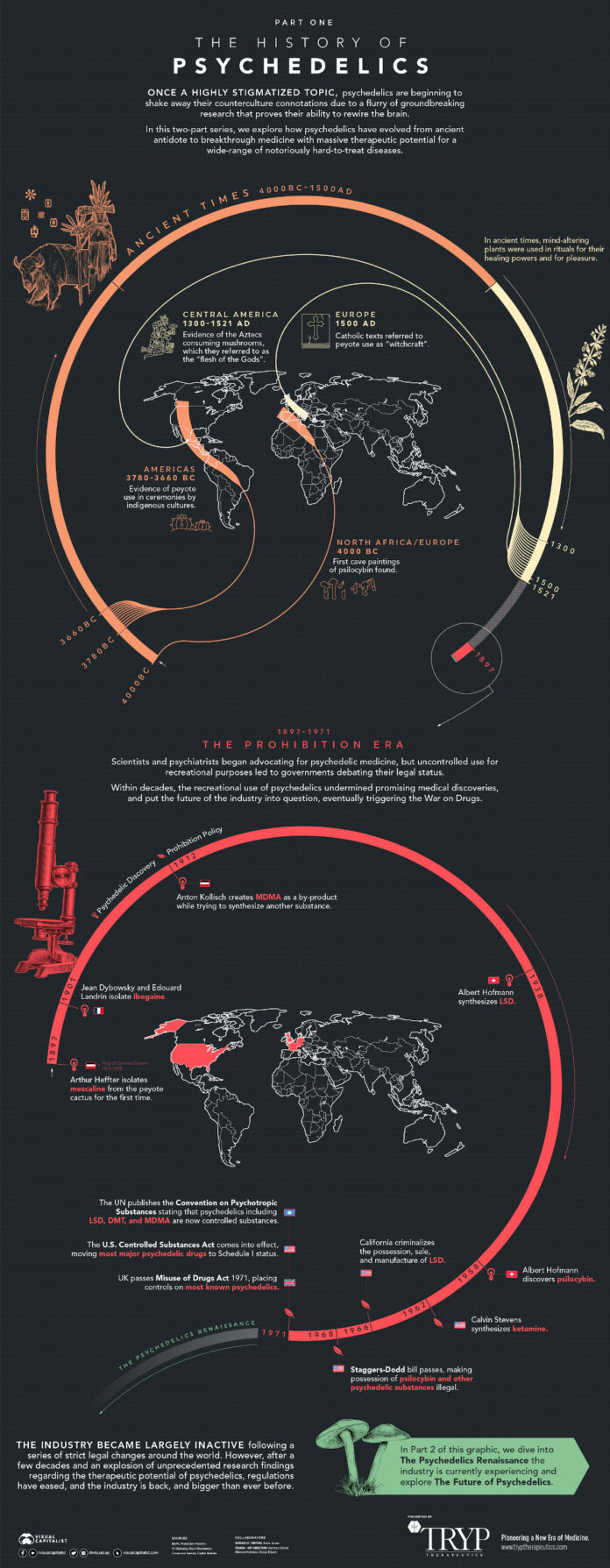History Of Psychedelics • Psychedelic Experience
Earlies evidence
DMT
Peyote
Salvia
Ayahuasca
MDMA
LSD
Psilocybin
- 7000 tot 9000 BCE – N. Africa Psilocybin use traces back to very prehistoric times.
Samorini, G. (1992) THE OLDEST REPRESENTATIONS OF HALLUCINOGENIC MUSHROOMS IN THE WORLD (SAHARA DESERT, 9000 – 7000 B.P.). Integration, 2/3: 69-78
- 6000 BCE – Spain Earliest murals of suspected Psilocybin Mushroom rituals.
Akers, B. P., Ruiz, J. F., Piper, A., & Ruck, C. A. (2011). A Prehistoric Mural in Spain Depicting Neurotropic Psilocybe Mushrooms? 1. Economic Botany, 65(2), 121-128. doi:10.1007/s12231-011-9152-5
Iboga
1950’s and 1960’s scientific research
- Over thousand scientific papers on psychedelics published, discussing around 40.000 patients; six international conferences on psychedelic drug therapy.
Grinspoon, L., & Bakalar, J. B. (1979). Psychedelic drugs reconsidered (pp. 221-223). New York: Basic Books.
- Example: Dr. Oscar Janiger, a psychiatrist who conducted studies on the effects of LSD in Los Angeles from 1954 till 1962. He conducted experiments with 900 participants, asking them for their phenomenological experiences. The follow up analysis of the data from 45 participants suggests that LSD can be safely administered in controlled doses to healthy humans by researchers trained in psychotherapy. Doblin, R., Beck, J. E., Chapman, K., & Alioto, M. (1999). Dr. Oscar Janiger’s Pioneering LSD Research: A Forty Year Follow-up. Bulletin of the Multidisciplinary Association for Psychedelic Studies, 9, 7-21.
- Expansion of the hippie movement, which promoted the use of psychedelic drugs such as marijuana and LSD as harmless and non-addictive ones, in order to explore the altered states of consciousness.
The Hippie Counter Culture Movement (1960’s)
Mid 1960s prohibition
- All scientific psychedelic research on humans banned in U.S.
Fadiman, J., Grob, C., Bravo, G., Agar, A., & Walsh, R. (2003). Psychedelic research revisited. Journal of Transpersonal Psychology, 35(2), 111-126.
- October 1966 – LSD was considered as having a negative impact on the values of the Western middle class and declared a controlled substance in California. The rest of the world followed. After that, the LSD black market emerged. United States. (1968). Increased controls over hallucinogens and other dangerous drugs: Hearings, Ninetieth Congress, second session, on H.R. 14096 … [and] H.R. 15355. Washington: U.S. Govt. Print. Off.
- 1967 – Summer of Love-San Francisco. Around 100,000 people gathered, influenced by the movement and lifestyle.
Selvin, J. (1994). Summer of love: the inside story of LSD, rock & roll, free love, and high times in the wild West. EP Dutton.
- October 1970 – LSD was considered as having a negative impact on the values of the Western middle class and declared a controlled substance in California. The rest of the world followed. After that, the LSD black market emerged. End the Ban on Psychoactive Drug Research [online]
- 1986 – Second Summer of Love-Britain. A renaissance of acid house music and rave parties. Supported MDMA and LSD use. Reynolds, S. (1998). Energy Flash: A Journey Through Rave Culture and Dance Music. Picador, London.
Credits


